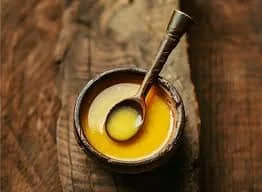In an era of diet trends and nutrition fads, one ancient ingredient continues to stand the test of time — Desi Cow Ghee. Loved by grandmothers, praised in Ayurveda, and now rediscovered by modern science, this golden nectar is more than just a cooking fat. It’s a medicine, a ritual, and a sacred offering — all rolled into one.
But is it really as miraculous as it’s made out to be? Let’s explore what Ayurveda and science say about it — and why ghee from indigenous Indian cows is truly in a league of its own.
What Is Desi Cow Ghee?
Desi Cow Ghee is clarified butter made from the milk of indigenous Indian cows like Gir, Sahiwal, Tharparkar, and Malnad Gidda. Unlike commercial ghee, true Desi Ghee is made via the traditional bilona method, where curd is churned to extract butter, which is then slowly simmered into ghee.
It’s not just a food — it’s Sanskaar.
What Ayurveda Says
Ayurveda describes ghee as a sattvic food — one that nourishes the body, mind, and soul. According to the Charaka Samhita, ghee:
- Enhances memory, digestion, and immunity
- Lubricates joints and tissues (snehana)
- Acts as a carrier (anupana) for herbal medicines
- Balances Vata and Pitta doshas
- Improves mental clarity and ojas (vital energy)
In Panchakarma detox therapy, ghee is used to pull toxins out from deep tissues — a testament to its unique penetrative power.
Modern Science Agrees
Recent studies have shown that A2 ghee from desi cows is rich in:
- Butyric acid – boosts gut health
- CLA (Conjugated Linoleic Acid) – supports fat loss and heart health
- Omega-3 fatty acids – anti-inflammatory and brain-supporting
- Vitamin A, D, E & K – fat-soluble, essential for vision, immunity, bones
What’s even more amazing? Ghee has a high smoke point (~250°C), making it ideal for cooking without breaking down into harmful compounds.
A1 vs A2 Ghee: Know the Difference
| Feature | A1 Ghee (Crossbreed/Hybrid Cows) | A2 Ghee (Desi Indian Cows) |
| Protein Type | A1 beta-casein (linked to health issues) | A2 beta-casein (easier to digest) |
| Digestibility | Often problematic | Gut-friendly |
| Production Method | Commercial & high-yield focused | Traditional, bilona method |
| Energy Vibrations | Low | High (used in yagnas, puja) |
For families, children, the elderly, and spiritual seekers — A2 ghee is the right choice.
How to Use Desi Ghee Daily
- Mix in warm rice or rotis for satiety
- Swallow a spoonful early morning for detox (gandusha)
- Massage babies and elders for joint and skin benefits
- Use in nasyam (Ayurvedic nasal therapy) for mental clarity
- Light a diya with ghee for spiritual energy
Desi cow ghee is not fattening when used correctly — it enhances metabolism and reduces cravings.
But Isn’t Ghee Expensive?
True bilona ghee takes 30–35 litres of milk to make just 1 litre of ghee. When sourced from desi cows fed natural fodder, cared for in ethical gaushalas, the cost is a reflection of its purity, potency, and process — not marketing hype.
What you pay for is not just ghee,
but the health of a cow, the income of a farmer, and the wisdom of our ancestors.
Support the Source: Your Ghee, Their Shelter
When you purchase ghee from Sri Sri Gaushala, you directly support the 1600+ cows who live freely and peacefully here. Every spoon of our ghee carries:
- The purity of vedic process
- The strength of indigenous breeds
- The love of a non-commercial cause
Try It Yourself
Experience the richness of Desi Cow Ghee from Sri Sri Gaushala
100% natural, bilona method, A2 certified
click to buy
In Conclusion
Desi Cow Ghee is not a trend — it’s our timeless tradition.
When taken with reverence, it heals the body.
When offered in a lamp, it sanctifies a home.
When used in rituals, it uplifts the spirit.
And when made with love, it sustains a cow’s life.
Let us not just consume ghee — let us respect it, share it, and support its sacred source.

